The document is a lecture on Java inheritance, detailing its definition, importance, and types including single, multilevel, hierarchical, and multiple inheritance. It explains concepts such as method overriding, aggregation, constructors in inheritance, static and dynamic binding, and the rules governing them. Code examples illustrate these concepts, highlighting how inheritance enables code reusability and the nuances of overriding methods.
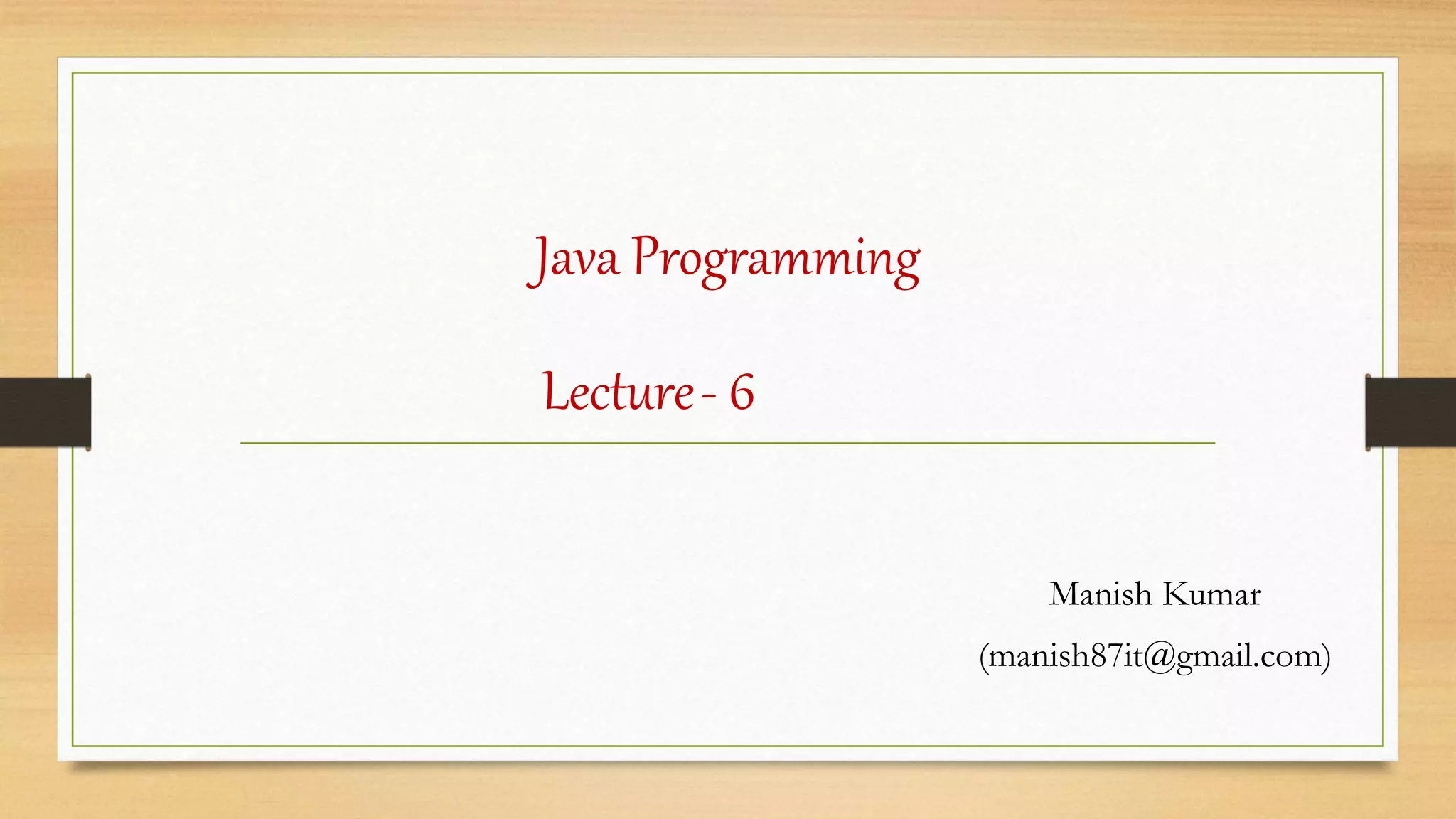
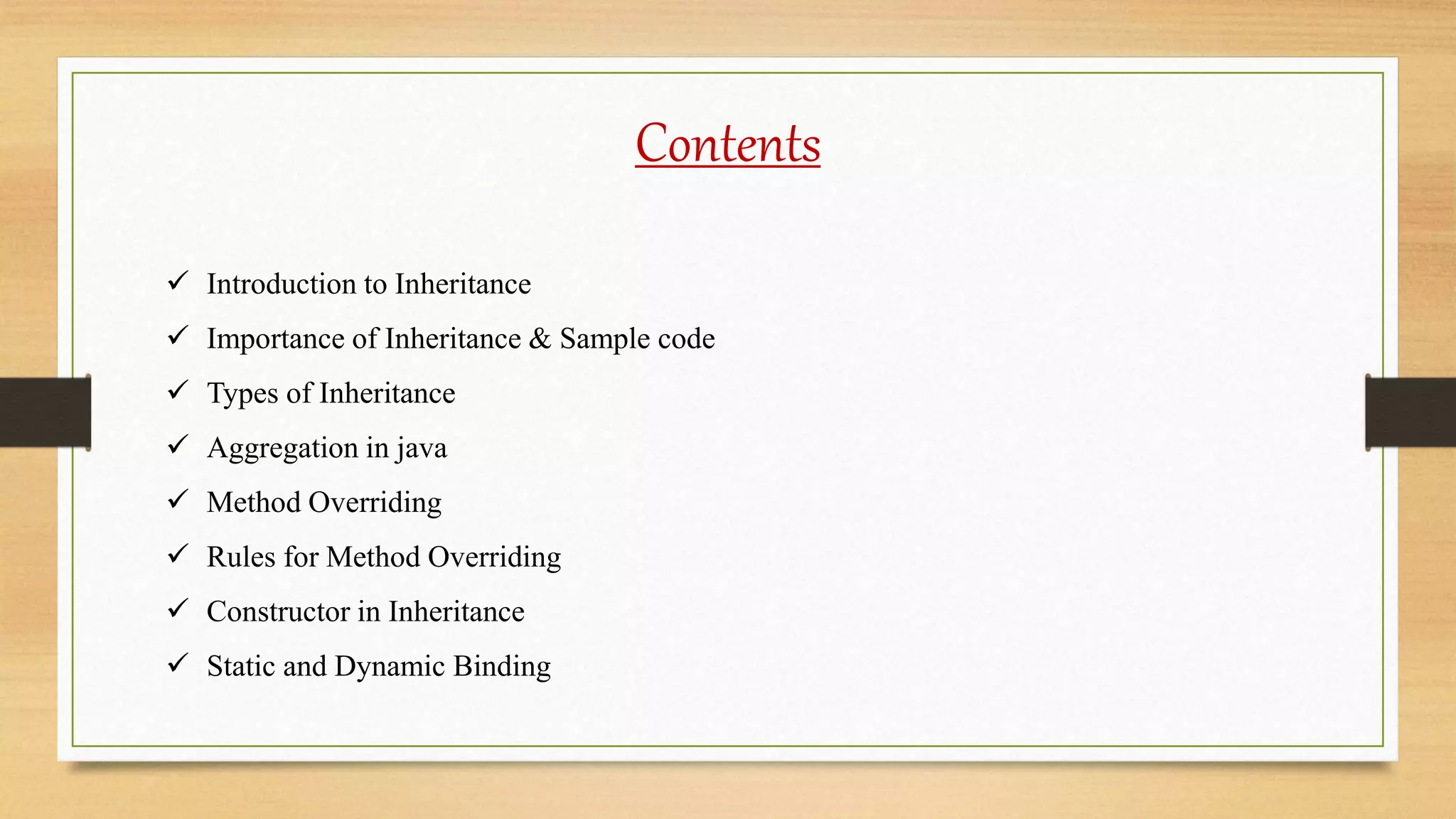
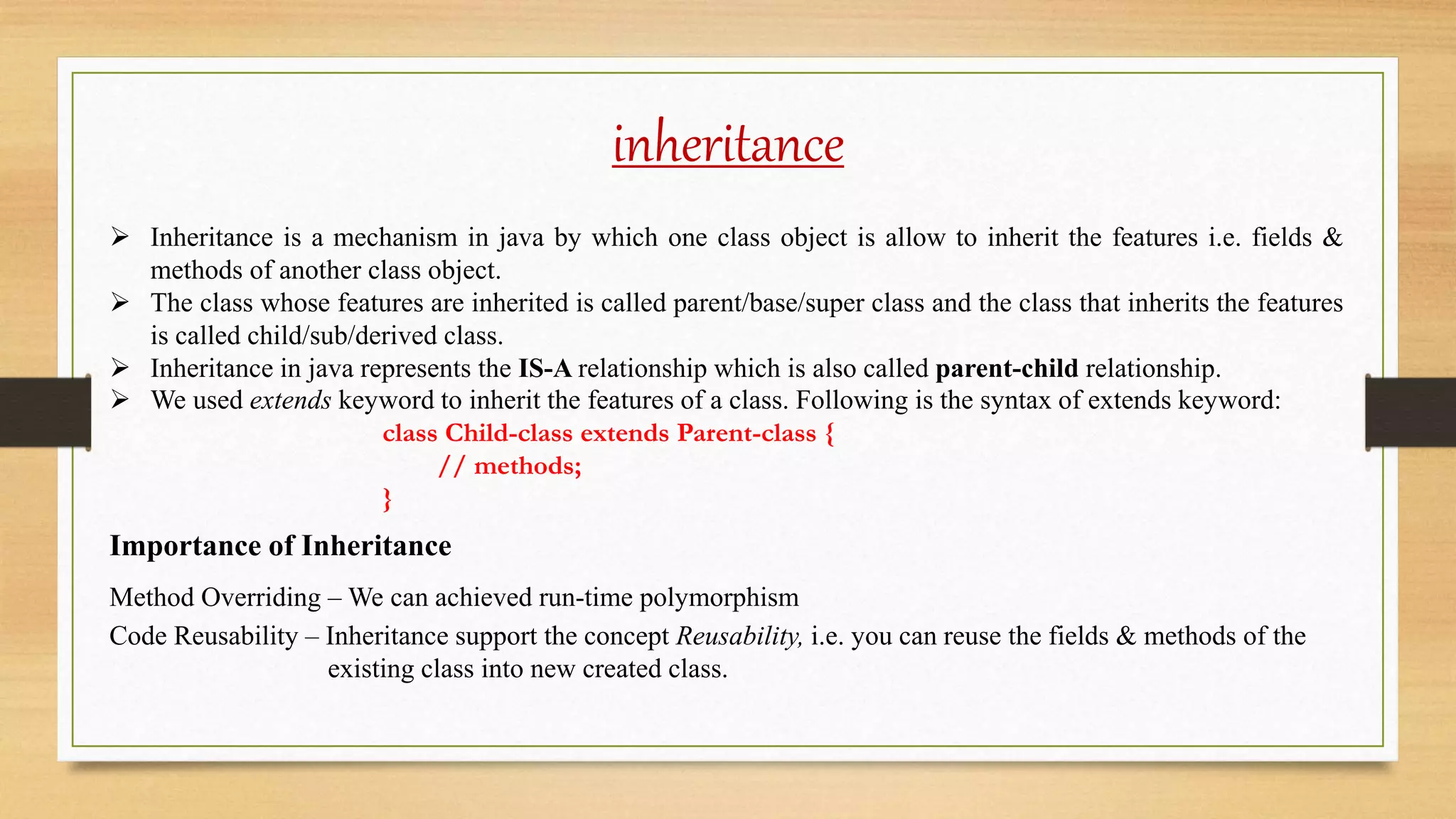
![Sample Code class Employee{ float salary=40000; } class Developer extends Employee{ int bonus=10000; public static void main(String args[]){ Developer d=new Developer (); System.out.println("Programmer salary is:"+d.salary); System.out.println("Bonus of Programmer is:"+d.bonus); } } Output - Programmer salary is: 40000.0 Bonus of programmer is: 10000 Employee.java In this code, Developer object can access the field of own class as well as of Employee class, i.e. code reusability. As we seeing in this code, Developer is the child class and Employee is the parent class. The relationship between the classes is Developer IS-A Employee. It means that Developer is a type of Employee.](https://image.slidesharecdn.com/lecture-6inheritance-200917174810/75/Lecture-6-inheritance-4-2048.jpg)
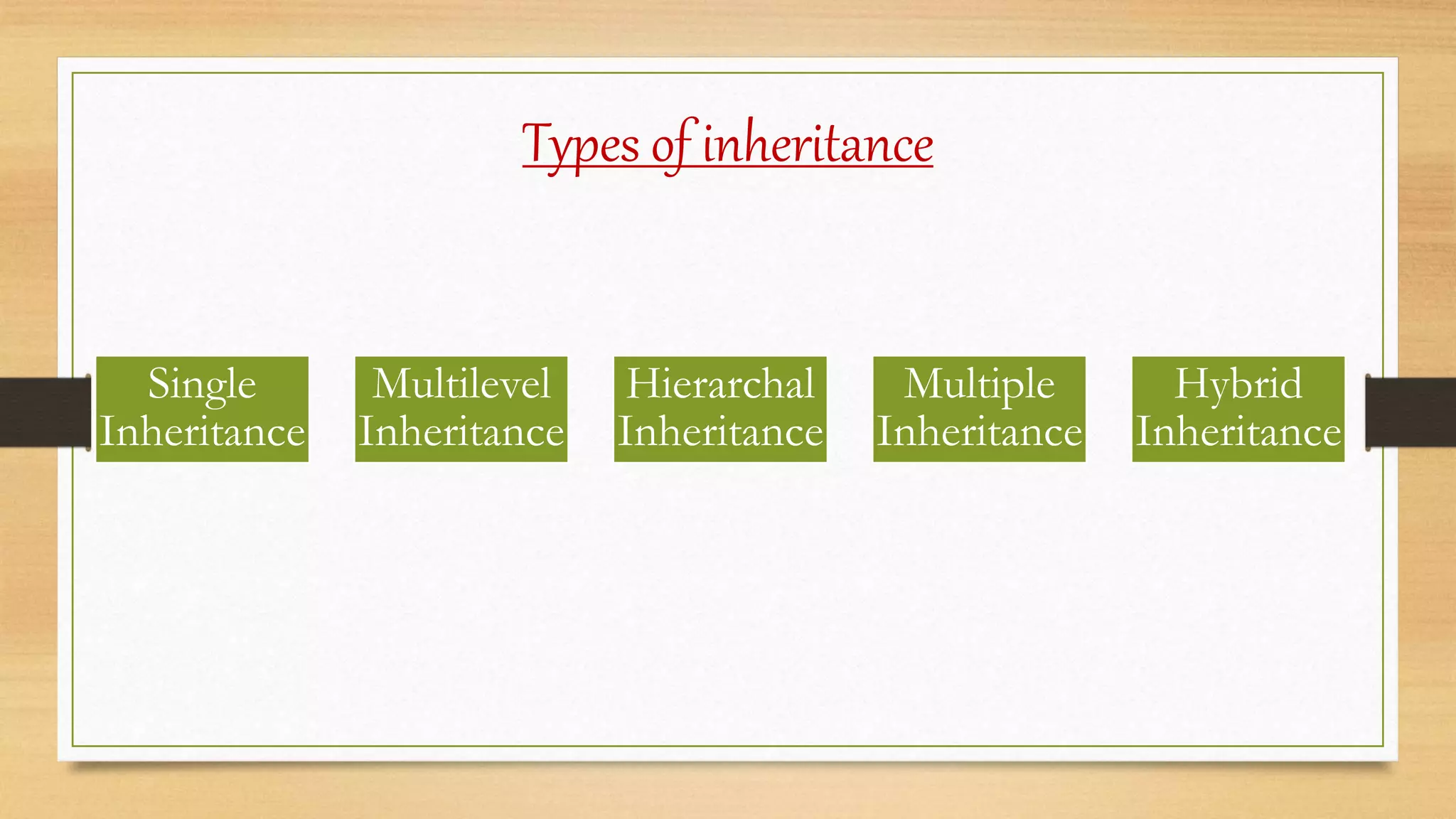
![Single inheritance In single inheritance, one sub-class and one-super- class. Super-class Sub-class // Test.java class Demo { void display() { System.out.println(“Sparsh Globe”); } } class Test extends Demo { public static void main(String args[]) { Demo d = new Demo(); d.display(); } } Output - Sparsh Globe In this example, we can see that Test class inherit the features of Demo class, so there is a single inheritance.](https://image.slidesharecdn.com/lecture-6inheritance-200917174810/75/Lecture-6-inheritance-6-2048.jpg)
![Multilevel inheritance When there is a chain of inheritance is called Multilevel Inheritance, i.e. when a derived class act as the parent class to other class. //Main.java class First { void show1() { System.out.println(“S. Globe”); } } Class Second extends First { void show2() { System.out.println(“Sparsh Globe”); } } class Third extends Second { void show3() { System.out.println(“Third Class”); } } class Main { public static void main(String args[]) { Third t = new Third(); t.show1(); t.show2(); t.show3(); } } Output - S. Globe Sparsh Globe Third Class A B C](https://image.slidesharecdn.com/lecture-6inheritance-200917174810/75/Lecture-6-inheritance-7-2048.jpg)
![Hierarchal inheritance A single class can inherited by two or more than two class, known as Hierarchal Inheritance. A AAA // Test.java class First { void show1() { System.out.println("S. Globe"); } } class Second extends First { void show2() { System.out.println("Sparsh Globe"); } } class Third extends First { void show3() { System.out.println("Third Class"); } } class Test { public static void main(String args[]) { Third t = new Third(); t.show1(); t.show3(); Second s = new Second(); s.show2(); } } Output - S. Globe Third Class Sparsh Globe](https://image.slidesharecdn.com/lecture-6inheritance-200917174810/75/Lecture-6-inheritance-8-2048.jpg)
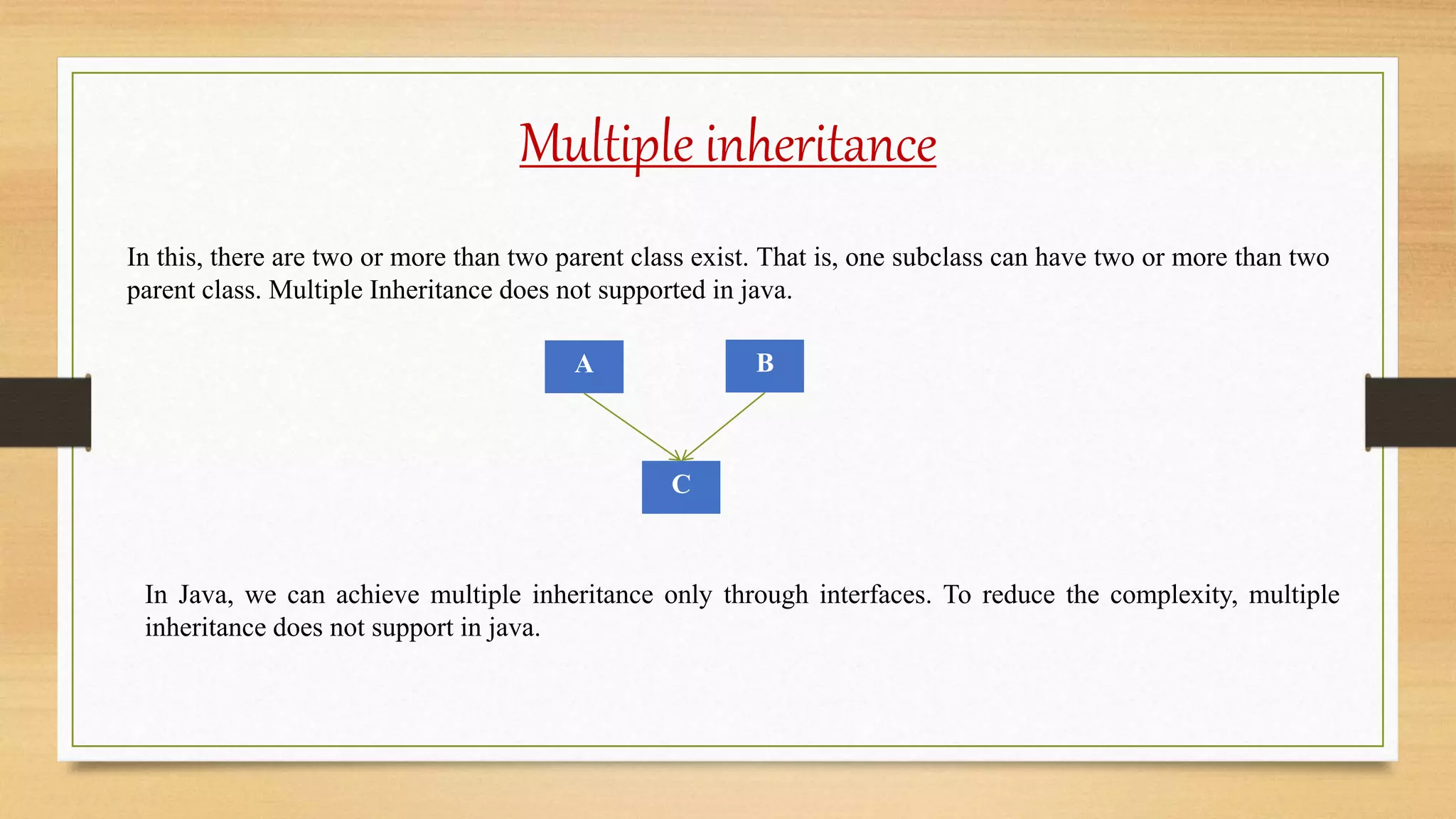
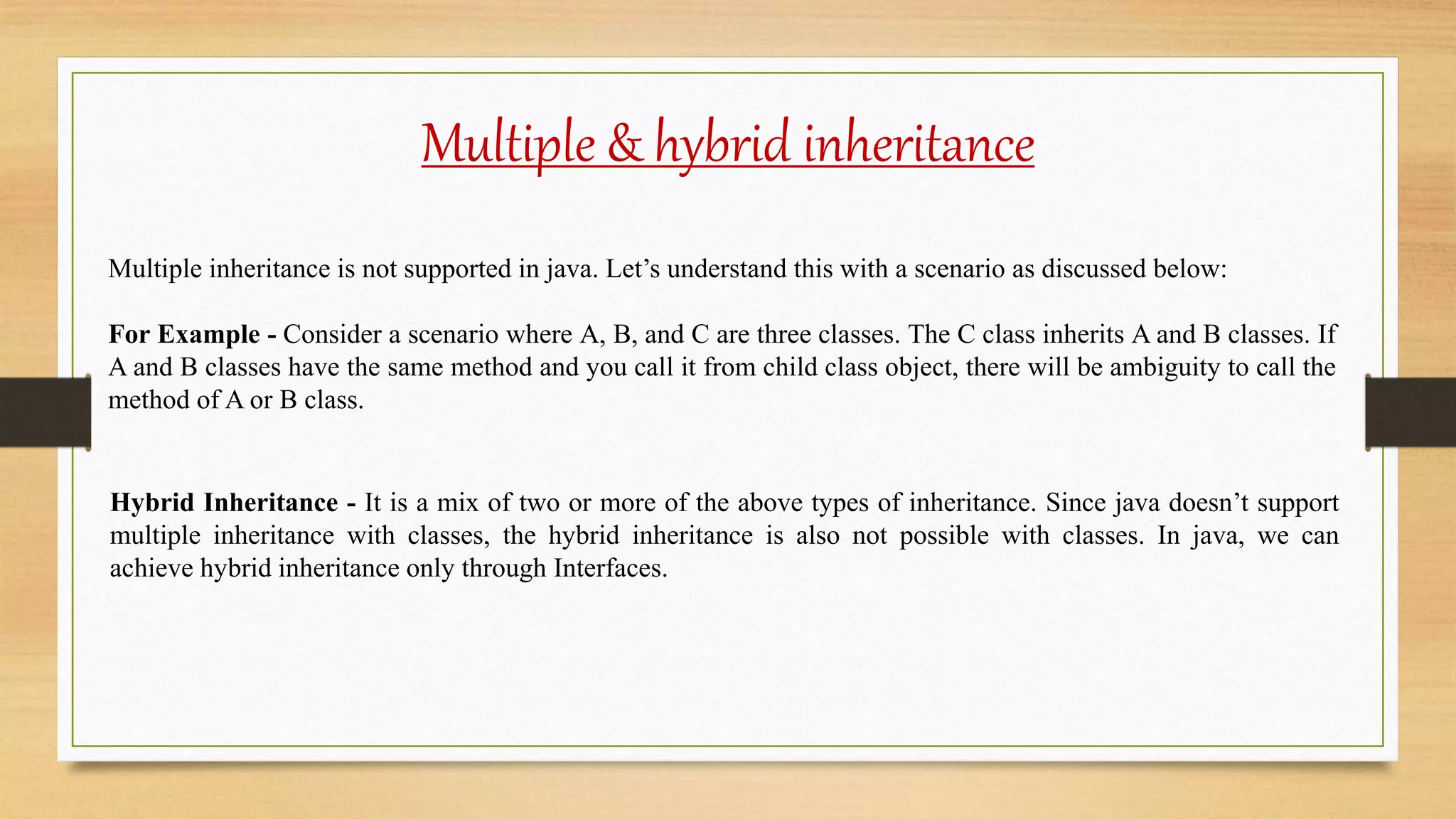
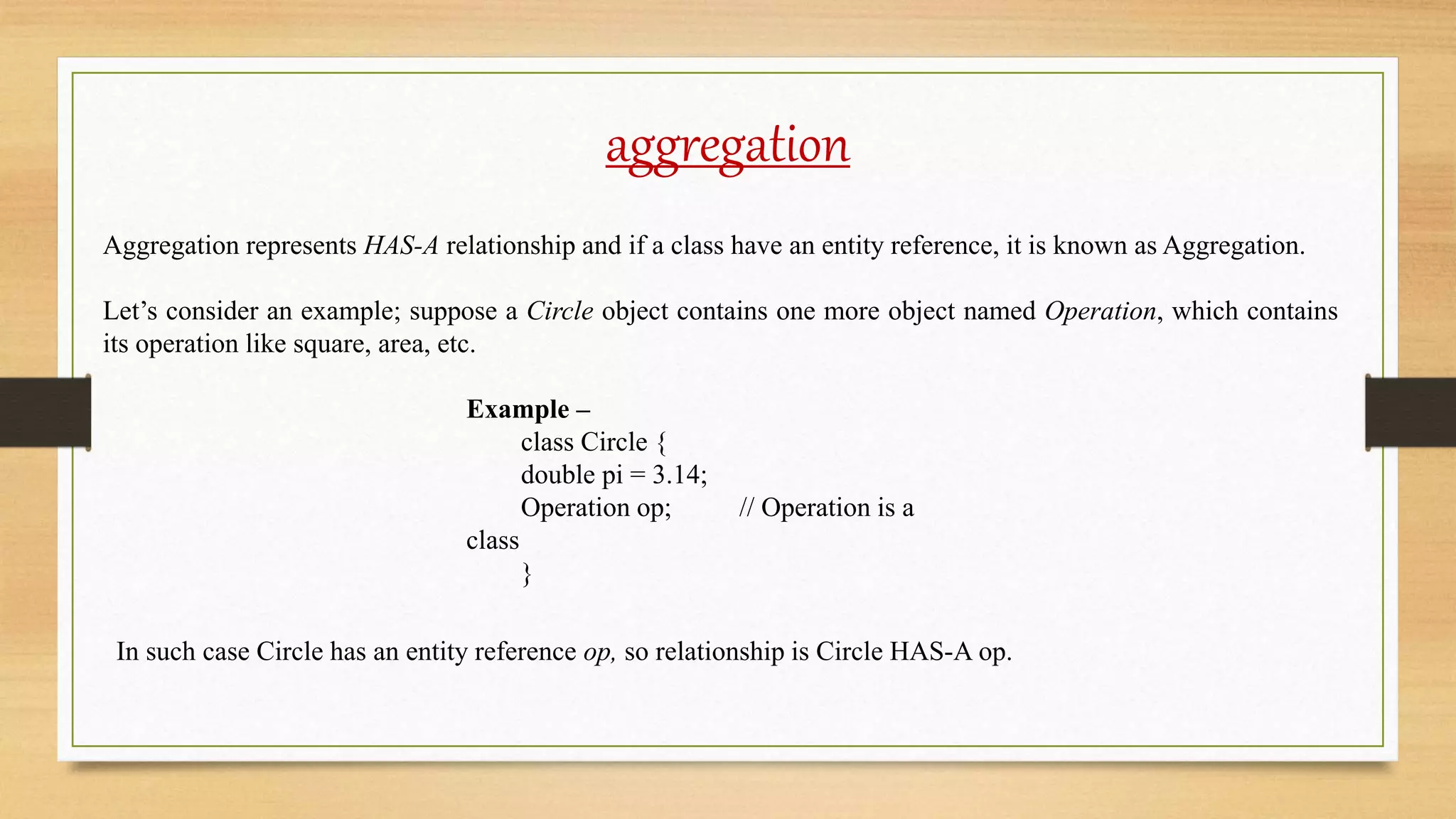
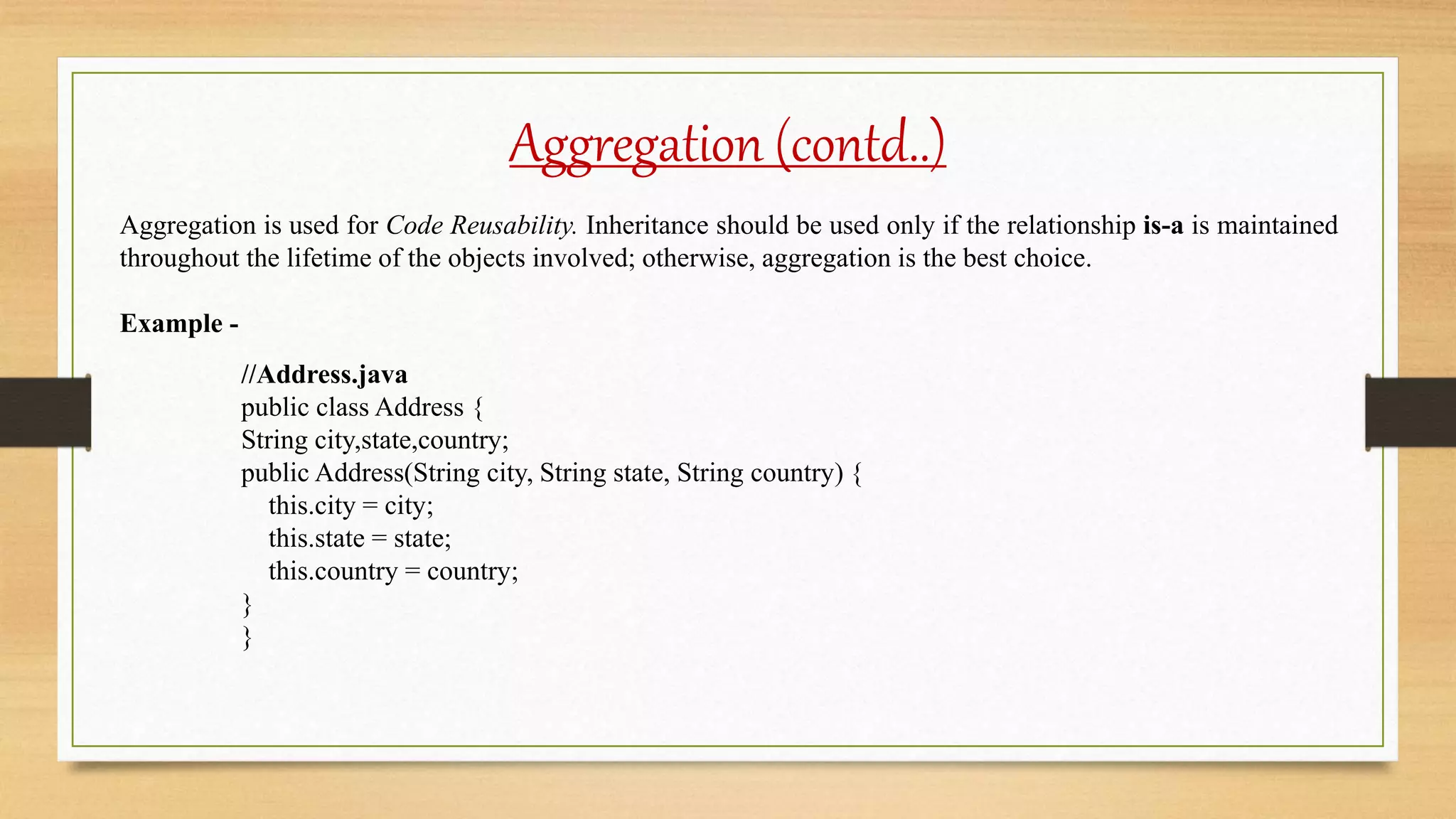
![aggregation //Emp.java public class Emp { int id; String name; Address address; public Emp(int id, String name,Address address) { this.id = id; this.name = name; this.address=address; } void display(){ System.out.println(id+" "+name); System.out.println(address.city+" "+address.state+" " +address.country); } public static void main(String[] args) { Address address1=new Address("KNP","UP","india"); Address address2=new Address("LKO","UP","india"); Emp e=new Emp(101,"Manish",address1); Emp e2=new Emp(102,"Sparsh",address2); e.display(); e2.display(); } } Output – 101 Manish KNP UP India 102 Sparsh LKO UP India](https://image.slidesharecdn.com/lecture-6inheritance-200917174810/75/Lecture-6-inheritance-13-2048.jpg)
![Method overriding Overriding is a concept in which a sub-class to provide a specific implementation of a method that is already provided by one of its super-class. In this concept, sub-class has a method with same name, parameter/signature and return type as contains in super-class. In this case we say that method of sub-class override the method of super-class. We can achieve Run Time Polymorphism, with the help Method Overriding. //Circle.java class Polygon { public void area() { System.out.println(“Area of Polygon is calculated”); } } class Circle extends Polygon { public void area() { System.out.println(“Area of Circle is calculated”); } public static void main(String args[]) { // If a parent type reference refers to child object Polygon p = new Circle(); // circle’s area() is called. This is called Run Time Polymorphism. p.area(); } } Output- Area of Circle is calculated](https://image.slidesharecdn.com/lecture-6inheritance-200917174810/75/Lecture-6-inheritance-14-2048.jpg)
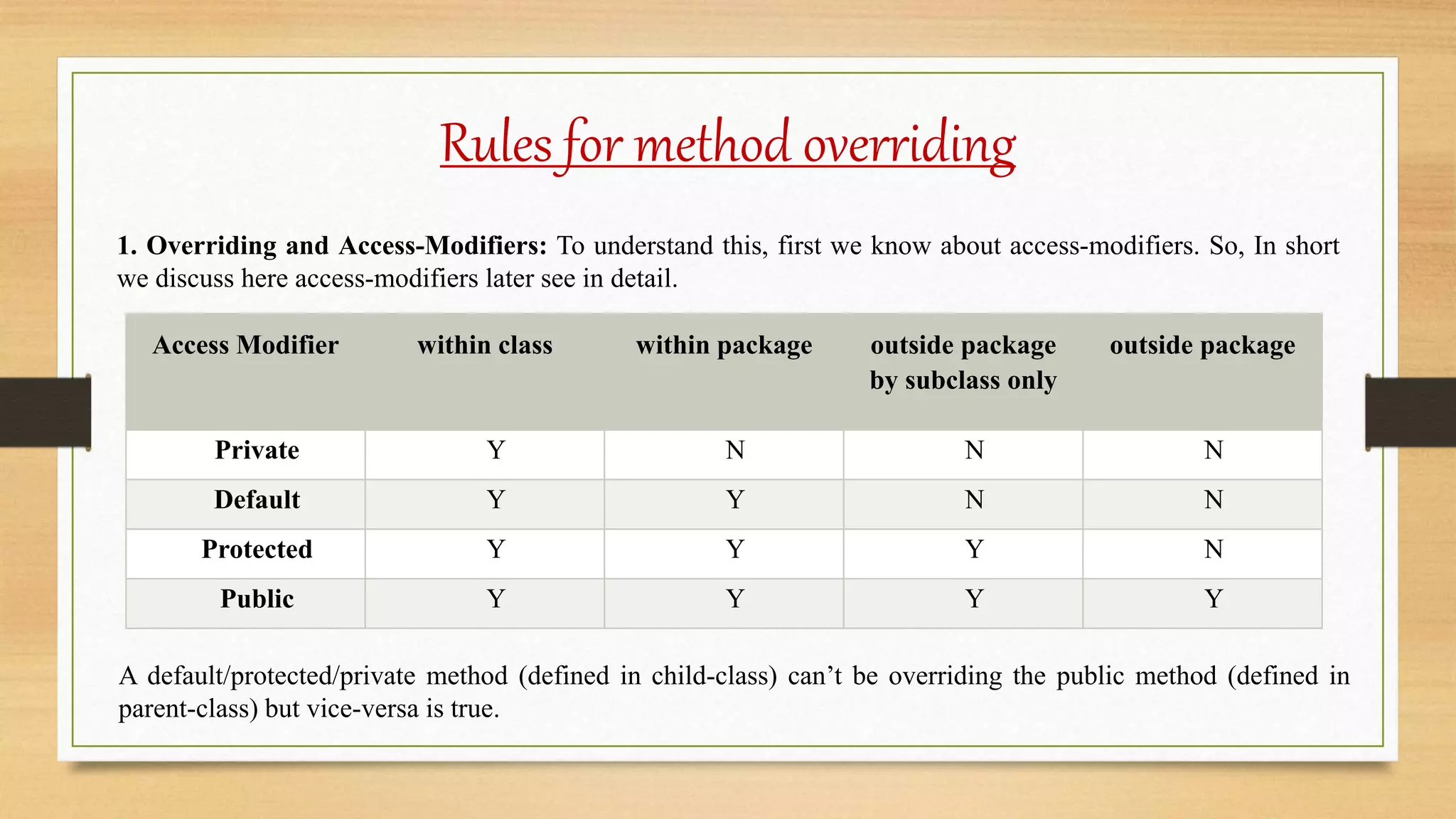
![1-Overriding and access modifiers // Test.java class First { public void show1() { System.out.println("S. Globe"); } } class Second extends First { void show1() { System.out.println("Sparsh Globe"); } } class Test { public static void main(String args[]) { Second t = new Second(); t.show1(); } } Output – error: show1() in Second cannot override show1() in First void show1() { ^ attempting to assign weaker access privileges; was public](https://image.slidesharecdn.com/lecture-6inheritance-200917174810/75/Lecture-6-inheritance-16-2048.jpg)
![2-Overriding and Final If we declare a method as final in java, it means that we cannot override this method. //FinalMethod.java class First { final void show1() { System.out.println("Final Method"); } } class Second extends First { void show1() { System.out.println("Sparsh Globe"); } } class FinalMethod { public static void main(String args[]) { Second t = new Second(); t.show1(); } } Output – error: show1() in Second cannot override show1() in First void show1() { ^ overridden method is final](https://image.slidesharecdn.com/lecture-6inheritance-200917174810/75/Lecture-6-inheritance-17-2048.jpg)
![3-Overriding and static method In the case static method, it will execute like overriding but this concept is not called overriding because of not achieving Run-Time Polymorphism. Hence the answer is – we cannot override the static method. This concept is known as Method Hiding. A static method cannot be overridden by an instance method and an instance method cannot be hidden by static method. class First { //StaticMethod.java static void show1() { System.out.println("Final Method"); } } class Second extends First { void show1() { System.out.println("Sparsh Globe"); } } class StaticMethod { public static void main(String args[]) { Second t = new Second(); t.show1(); } } Output – Sparsh Globe](https://image.slidesharecdn.com/lecture-6inheritance-200917174810/75/Lecture-6-inheritance-18-2048.jpg)
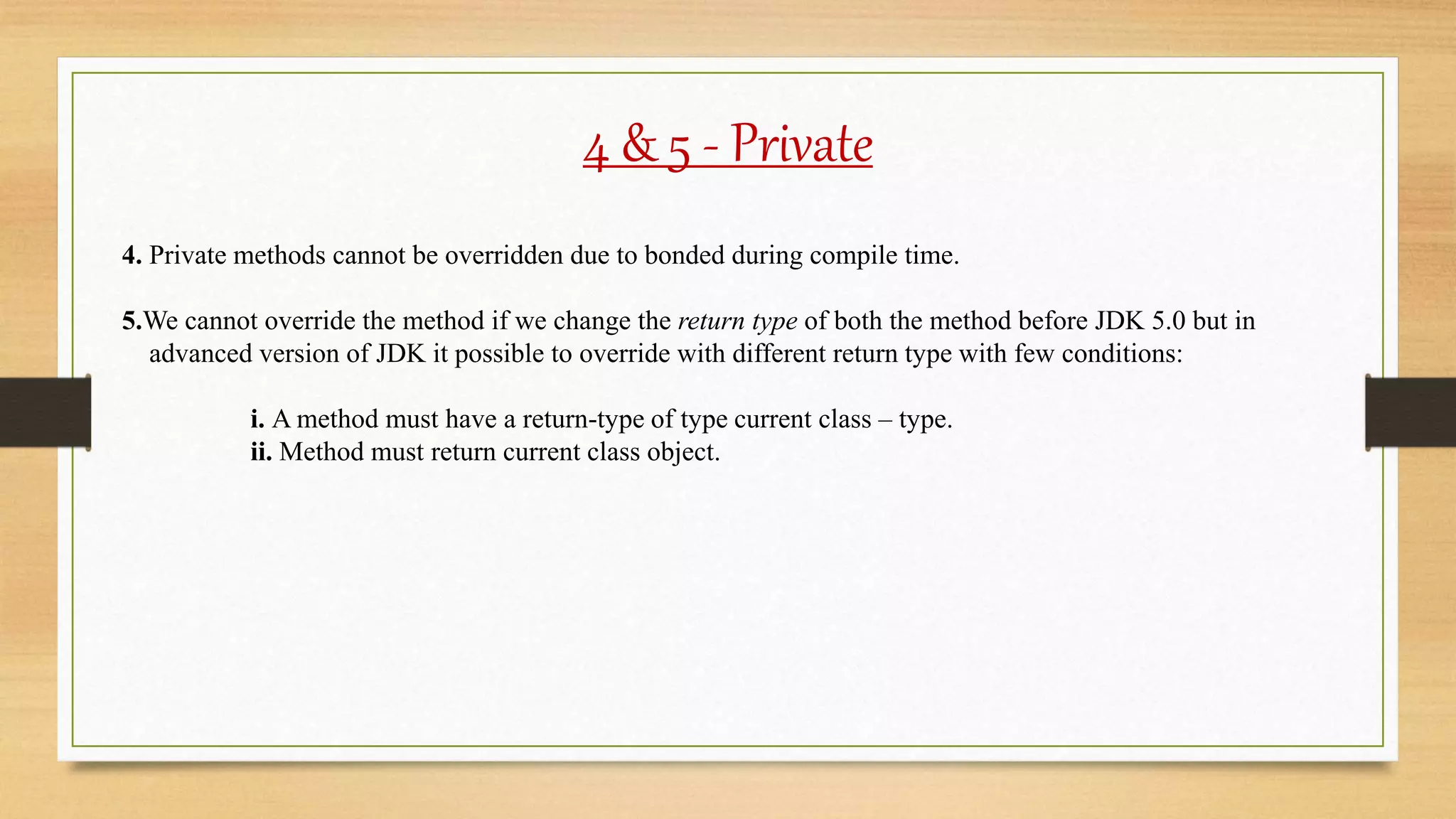
![4 & 5 - Private Example – (Test.java) – This concept is called covariant return type. class First { First show1() { System.out.println("Final Method"); return new First(); } } class Second extends First { Second show1() { System.out.println("Sparsh Globe"); return new Second(); } } class Test { public static void main(String args[]) { Second t = new Second(); t.show1(); } } Output – Sparsh Globe](https://image.slidesharecdn.com/lecture-6inheritance-200917174810/75/Lecture-6-inheritance-20-2048.jpg)
![Constructor in inheritance In java, constructor in inheritance operates in different way i.e. un-parameterized constructor of base class gets automatically called in child-class constructor. Example – (ConstructorInInheritance.java) class First { First() { System.out.println("Base class"); } } class Second extends First { Second() { System.out.println("Child class"); } } class ConstructorInInheritance { public static void main(String args[]) { new Second(); } } Output - Base class Child class](https://image.slidesharecdn.com/lecture-6inheritance-200917174810/75/Lecture-6-inheritance-21-2048.jpg)
![Constructor in inheritance But if we want to call parameterized constructor defined in base class, then we must use super() method but remember this method must be the first line in child-class constructor. Example – (ConstructorInInheritance.java) class First { First(int x) { System.out.println("Base class - "+x); } } class Second extends First { Second() { Super(10); System.out.println("Child class"); } } class ConstructorInInheritance { public static void main(String args[]) { new Second(); } } Output - Base class - 10 Child class Note – Constructors are never being inherited.](https://image.slidesharecdn.com/lecture-6inheritance-200917174810/75/Lecture-6-inheritance-22-2048.jpg)
![Static binding Static binding is also known as Early Binding. If the type of object is determined by the compiler, then it is known as Static Binding. If any class has private, final or static method, it means there is static binding. Example – (StaticBinding.java) class StaticBinding { private void show() { System.out.println("static binding"); } public static void main(String args[]) { StaticBinding sb = new StaticBinding (); sb.show(); } } Output – static binding](https://image.slidesharecdn.com/lecture-6inheritance-200917174810/75/Lecture-6-inheritance-23-2048.jpg)
![dynamic binding If the type of object is determined at run-time then it is known as Dynamic Binding. It is also known as Late Binding. Example – (DynamicBinding.java) class Polygon { void area(){ System.out.println("Area of Polygon"); } } class Circle extends Polygon { void area(){ System.out.println("Area of Circle"); } } class Test { public static void main(String args[]){ Polygon p=new Circle(); p.area(); } } Output – Area of Circle](https://image.slidesharecdn.com/lecture-6inheritance-200917174810/75/Lecture-6-inheritance-24-2048.jpg)
